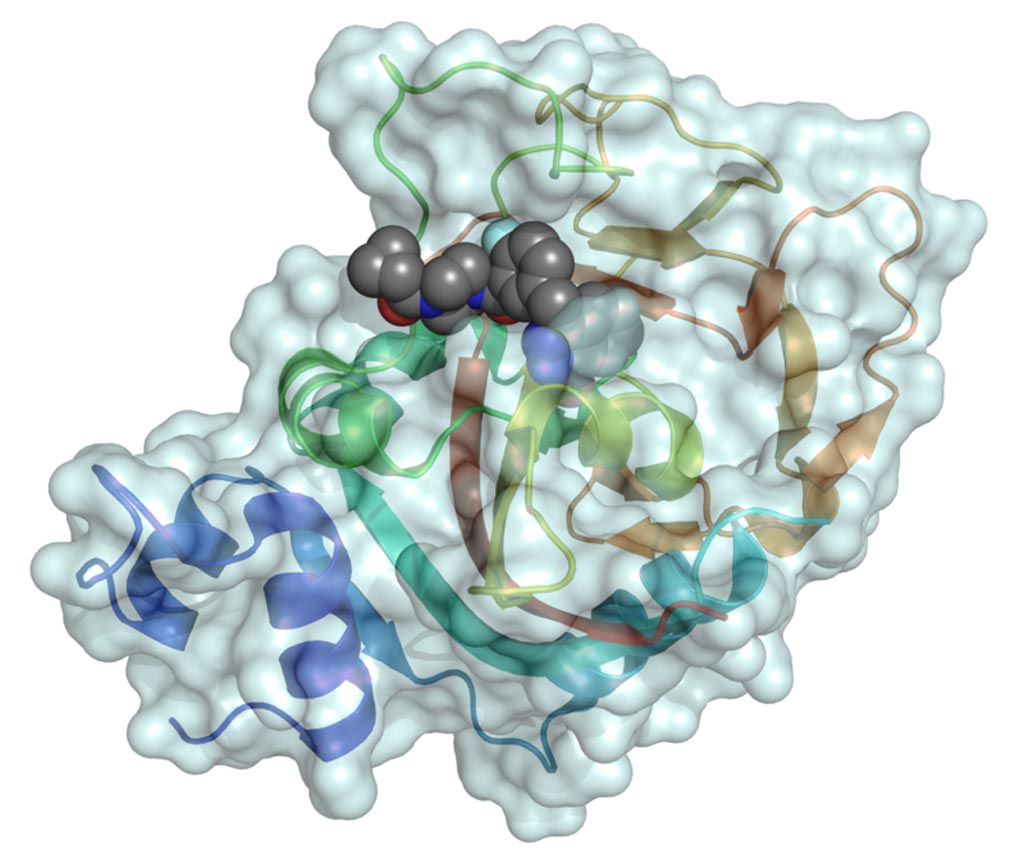Anticancer Duo Kills Tumors While Preventing Relapse
By LabMedica International staff writers
Posted on 28 Jun 2018
A suggested new therapeutic approach for killing tumor cells simultaneously blocks both the PARP and RAD52 DNA repair pathways.Posted on 28 Jun 2018
Previous studies have shown that BRCA (BReast CAncer susceptibility gene) deficient breast carcinoma cells and leukemia cells could not be completely eradicated by inhibitors of the enzyme Poly (ADP-ribose) polymerase (PARP). The main role of PARP is to detect and initiate an immediate cellular response to metabolic, chemical, or radiation-induced single-strand DNA breaks (SSB) by signaling the enzymatic machinery involved in the SSB repair.

Image: A mixed surface–ribbon representation of the catalytic domain of human poly (ADP-ribose) polymerase 1 (PARP1) binding the small-molecule inhibitor olaparib (shown as a space-filling model) (Photo courtesy of Wikimedia Commons).
The ability of cancer cells to recover from treatment with PARP inhibitors (PARPis) indicates that more robust and rapid elimination of BRCA-deficient tumor cells is required to prevent time-dependent emergence of PARPi-resistant or refractory clones.
Investigators at Temple University (Philadelphia, PA, USA) hypothesized that RAD52-mediated DNA repair remained active in PARPi-treated BRCA-deficient tumor cells, and that targeting RAD52 should enhance the synthetic lethal effect of PARPi.
In studies described in the June 12, 2018, issue in the journal Cell Reports, cancer cells were treated with the drug olaparib. Initially this drug acts as a PARP inhibitor. BRCA1/2 mutations may be genetically predisposed to development of some forms of cancer, and may be resistant to other forms of cancer treatment. However, these cancers sometimes have a unique vulnerability, as the cancer cells have increased reliance on PARP to repair their DNA and enable them to continue dividing. This means that drugs that selectively inhibit PARP may be of benefit if the cancers are susceptible to this treatment. However, over time cancer cells turn to backup repair mechanisms and adapt to alternative repair pathways, a survival mode that also underlies their ability to evade targeted drug therapies.
The investigators reported that RAD52 inhibitors (RAD52is) attenuated single-strand annealing (SSA) and residual homologous recombination (HR) in BRCA-deficient cells. Simultaneous targeting of PARP1 and RAD52 with inhibitors or dominant-negative mutants caused synergistic accumulation of DSBs and eradication of BRCA-deficient but not BRCA-proficient tumor cells. PARPi+RAD52i exerted synergistic activity against BRCA1-deficient tumors in immunodeficient mice with minimal toxicity to normal cells and tissues.
While the PARP inhibitor olaparib has been approved by the [U.S.] Food and Drug Administration for clinical use, no RAD52 inhibitors have yet been approved.
“Cancers cells have multiple ways of protecting themselves from death,” said senior author Dr. Tomasz Skorski, professor of microbiology and immunology at Temple University. “The tumor cells eventually escape PARP1 inhibition by activating another backup to the BRCA-mediated repair pathway. Our previous work had suggested that RAD52-dependent pathways are a likely escape route, which led us to see whether simultaneous inhibition of both PARP1 and RAD52 could trigger more effective lethality.”
Related Links:
Temple University













